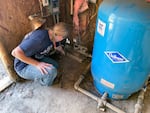The federal government is sending $1.7 million to Eastern Oregon to handle ongoing nitrate contamination in the groundwater just as local and state government services meant to address the crisis are going into flux.

FILE: A private well in the outskirts of Boardman, Ore., on April 15, 2022.
Monica Samayoa, Monica Samayoa / OPB
Nitrate pollution in the Lower Umatilla Basin has affected drinking water across Umatilla and Morrow counties for decades. And a recent series of tests on private wells have shown the water is unsafe to drink for hundreds of northern Morrow County residents. Some residents’ drinking water tested four to five times higher than the Environmental Protection Agency’s limit of 10 milligrams of nitrates per liter. Drinking high levels of nitrates can lead to detrimental health effects including respiratory infections, thyroid dysfunction and stomach or bladder cancer.
As a part of a federal funding package passed late last year, Congress approved $1.7 million to identify long-term solutions to the issue, “including creating a comprehensive inventory of domestic wells and testing the wells” to find out which homes are most in need of a different water source, according to a press release from the office of U.S. Sen. Jeff Merkley of Oregon.
Morrow County emergency manager Paul Gray confirmed that a county emergency order established in June expired on Dec. 31, but added that the county would still play an active role in helping residents deal with the nitrate issue.
“We are not just dumping this off on the state,” he said. “We’re going to be working no matter what. This is going to be an ongoing issue for a long time. We’re going to be working hand-in-hand with the state. We’re probably going to still manage quite a bit of this, we’re just passing all the cost to the state.”
The emergency manager said the county would still dedicate time and resources to the issue, but the state had better resources to provide wells with comprehensive tests. While the county’s testing focused on nitrates, Gray said the state could afford to test for a wider array of chemicals as well as the source of the contaminants.
Gray compared the situation to the Hurricane Sandy emergency response in 2012. While there was an immediate response to the natural disaster, it took years for the federal government to complete tasks like repairing and demolishing homes. Gray anticipated a similar timeline for the nitrate emergency.
Gray said he expected that some of the federal funding would “trickle down” to the county, but he still needed to get answers from state government officials before knowing what role the county would play.
High levels of nitrates have burdened the region for more than 30 years. The state declared it a groundwater management area in 1990, which creates a committee that’s tasked with identifying what’s causing the high levels of nitrate and to develop recommendations for reducing them.
The committee has recently begun restructuring to better address the issue and community concerns.
Water deliveries
While the federal government plots out a long-term solution to nitrate contamination, one of the key parts of the short-term response has a looming expiration date.
Shortly after the county declared an emergency in June, the Oregon Department of Human Services’ Office of Resilience and Emergency Management began supplying drinking water to residents affected by nitrate pollution in partnership with the Morrow County government, according to an email from spokesperson Sara Campos.
The department took over water distribution completely in December, signing an agreement with the county to supply up to $6,000 in water through the end of March 2023. Campos wrote that the state has enough funding to extend the deal until June 30.
Gray said about 170 households are receiving water deliveries.

In this April 2022 file photo, Morrow County resident Annie Philpott shows part of her home's water system, which relies on a private well that needs to be replaced.
Monica Samayoa / OPB
The federal funding comes at a critical time. With the county’s emergency order ending, some residents may no longer receive subsidized bottled water.
Oregon Rural Action executive director Kristin Ostrom, who is also a member of the groundwater committee, said without these services, many families will be left out of receiving clean drinking water.
“The problem that gave rise to this emergency, the toxic levels of nitrates in our region’s groundwater, has not yet been addressed or remedied,” she said. “The water is still undrinkable for many rural residents and the public’s health is still at risk.”
Ostrom’s group has been conducting door-to-door private well testing in Morrow County for the past year. So far, they’ve tested 512 wells — about 70% of the wells tested in rural Boardman showed high levels of nitrates and 30% of those tested in rural Irrigon, also tested high.
But Ostrom said there is another problem. The filters that have been installed in residents’ homes in the past few months aren’t sufficient. She said some don’t filter water quickly enough for a family of four. Her group has also discovered that the certified reverse osmosis filter systems approved to be installed, which remove minerals and harmful chemicals like nitrates from water, can only handle nitrate levels below 27 milligrams per liter.
“Yet of the testing we have done in Morrow County, we know there are 126 household wells that are in the mid-20′s and above,” she said. “So for those families, even the certified filter system is not going to get them the adequate water they need.”
Ostrom said a number of community members have sent Gov. Tina Kotek a letter, asking for her to sit down and meet with affected community members to discuss a short term and long term solution to the problem.
“The community is just asking lots of questions,” Ostrom said. “There is a great deal of anxiety, there is awareness that the Morrow emergency response has ended, there’s just lots and lots of questions.”